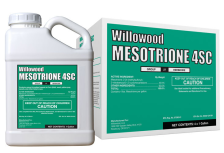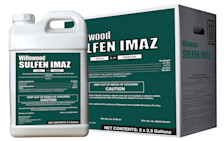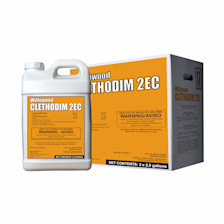Herbicides 101: Everything Growers Need to Know About Herbicides
This guide includes the following sections:
What Are Herbicides?
Herbicides are a type of pesticide used to control or kill weeds that negatively impact agricultural operations. They function by disrupting weed development, ultimately killing the weed or suppressing its growth. Herbicides can increase farm profitability by decreasing competition for plant resources, reducing host material for diseases and insects, decreasing manual labor costs and preventing the spread of troublesome weeds.
Herbicides fall into two categories:
Selective: Herbicides that only target specific types of plants.
Non-selective: Herbicides that will kill any plant they come into contact with.
Why Do Farmers Use Herbicides?
Herbicides offer several key benefits, including:
Improved crop yield and crop quality and subsequently increased ROI
Reduced need for manual labor in weed control, saving time and money
Less buildup of weed seeds in the soil, reducing weed populations over time
Less weed host material in fields, which reduces insect and disease pressure
Convenient cover crop destruction
Limited spread of invasive plant species, which can be harmful to native plants and wildlife
For more guidance on herbicide selection, review “Choosing the Right Post-Emergence Herbicide Applications for Your Farm.”
How to Select the Right Herbicide
Before selecting a particular herbicide to address a weed pressure, be sure to first assess your weeds. Identify exactly which types of weeds you are trying to treat and determine if they are annual, biennial or perennial.
Weeds that haven’t emerged can be controlled with pre-emergence herbicides with residual activity. Consider applying overlapping residual herbicides for troublesome weeds that have extended germination periods. This can be a reliable way to effectively control difficult, prolific weed species like waterhemp.
Target emerged weeds with contact or systemic herbicides. Contact herbicides, like Willowood Paraquat 3SL* or Willowood Glufosinate 280SL, kill plants through direct contact. Systemic herbicides, such as AgSaver™ Glyphosate 53.8%, 2,4-D or Dicamba DMA 4 Value Pick, travel through the plant’s vascular system to kill weeds. Selective herbicides specifically treat either broadleaf or grass weeds, while non-selective herbicides broadly kill all weeds.
For more herbicide selection best practices, review “Follow These 3 Steps to Simplify Your Herbicide Selection Process.”
What Are Herbicide Sites of Action and Modes of Action?
Herbicides are classified into different groups based on their site of action (SOA). A site of action is the location within a plant that is impacted when a herbicide is applied.
Mode of action (MOA) refers to the specific biochemical mechanism that herbicides use to kill weeds. Think of the site of action as where the herbicide works in the plant and the mode of action as how it works.
Some herbicides have the same mode of action but different sites of action. For example, Group 5, 6, and 7 herbicides are all photosynthesis inhibitors, but the different Group numbers indicate a different site of herbicide action in the plant. Repeated use of herbicides with the same site of action can increase the risk of developing herbicide-resistant weeds.
Understanding a herbicide’s SOA and MOA can help farmers select effective herbicides against target weeds while reducing herbicide resistance risk. Applying herbicides with multiple modes and sites of action and including proper adjuvants in the spray tank mix can help you get the most out of your weed management program.
There are several different herbicide groups, including:
Group 1: These herbicides target the plant's cell membranes and are effective against grassy weeds. They’re typically applied post-emergence.
Group 2: These herbicides target the plant's acetolactate synthase (ALS) enzyme and are effective against broadleaf weeds. They’re typically applied post-emergence.
Group 3: These herbicides target the plant's microtubules and are effective against grassy and broadleaf weeds. They’re typically applied to the soil before weed emergence.
Group 4: These herbicides target the plant's auxin receptors and are effective against broadleaf weeds.
Groups 5, 6 and 7: These herbicides target the plant's photosynthesis process and are effective against broadleaf weeds.
Group 9: These herbicides target the plant's EPSP synthase enzyme and are effective against a wide range of weeds.
Group 14: These herbicides target the plant's protoporphyrinogen oxidase (PPO) enzyme and are effective against broadleaf weeds.
For more information on herbicide groups and modes of action, click here.
How to Put Together the Right Tank Mix
If you’re looking to treat fields with a convenient, ready-to-go option, herbicide pre-mixes are already mixed in a specific ratio to provide broad-spectrum weed control.
While pre-mixes are available, you can also create a customized herbicide tank mix tailored to your specific weed management needs.
When developing an herbicide tank mix, you should be aware of the mixing order to maintain herbicide efficacy and reduce the potential for crop injury. It is generally best to add water conditioners and compatibility agents to the water carrier volume first.
Use the acronym DALES to remind you of the proper mixing order:
D (dry formulations): Next, add dry formulations, including wettable powders, water-dispersible granules, water-soluble packets and dry flowables.
A (agitate): Ensure continuous agitation throughout the mixing process.
L (liquid formulations): Follow with liquid formulations, including flowables and soluble concentrates.
E (emulsifiable concentrates): Add emulsifiable concentrates first, followed by microencapsulated formulations.
S (surfactants): Finish with surfactants and adjuvants like crop oil and drift control agents.
Adjuvants are substances that improve the performance and efficacy of the herbicide by enhancing spray characteristics. They can help increase the herbicide's absorption and penetration into the plant and enhance herbicide coverage and distribution into the crop’s canopy. Adjuvants can also help to reduce the amount of herbicide needed for effective control, which can help to reduce costs and minimize the risk of herbicide resistance. Some examples of adjuvants include surfactants, oils, and drift control agents.
When developing an herbicide tank mix, you should also be aware of antagonism.
Antagonism occurs when two or more herbicides are mixed, reducing the effectiveness of one or more herbicides. This can happen when the herbicides have similar modes of action or when one herbicide interferes with the absorption or translocation of another herbicide. To avoid antagonism, carefully select herbicides with different modes of action and avoid mixing herbicides known to be antagonistic.
It is important to always read and follow the label instructions for each herbicide and adjuvant used in the tank mix to avoid any potential crop damage.
For additional insights on herbicide tank mixing order, check out “Tips for Your Herbicide Mixing Order.”
When to Apply Herbicides
The ideal weather conditions for herbicide application can vary depending on the specific herbicide being used. However, in general, it is best to apply herbicides when the weather is calm, with little to no wind and when there is no rain in the forecast for at least 24 hours. Additionally, it is important to consider the temperature and humidity levels, as these can affect herbicide efficacy.
Herbicides can be applied through a variety of methods, including aerial or ground spraying, injection, dusting, or spreading. Application methods and benefits depend on the type of herbicide being applied and the size of the area being treated.
Keep in mind a herbicide’s rotational crop interval when planning your weed control strategy. For example, the rotational crop interval for planting legumes after using Willowood Mesotrione 4SC is 18 months. If you use herbicides for cover crop destruction before planting a cash crop, you’ll need to watch rotational restrictions closely.
Review all label guidance when using an herbicide product to ensure you follow all application, use, and future planting recommendations.
For more spraying recommendations, review FBN expert tips in “4 Ways to Minimize Spray Drift” and “Types of Spray Nozzles and How to Choose the Right One.”
How to Manage Common Weeds Using Herbicides
Using Herbicides to Control Waterhemp
Waterhemp is a highly competitive broadleaf weed capable of producing up to 1 million seeds per plant, reducing yields by competing with crops for nutrients, water and sunlight. It can be challenging to control as some populations have developed resistance to multiple herbicide classes. If left unchecked, waterhemp can quickly spread throughout a field and reduce overall crop productivity.
While controlling waterhemp can be challenging, layering pre-emergence and post-emergence herbicides with residual control can help manage the weed. Two herbicides that are labeled for use on waterhemp are AgSaver™ Glyphosate 53.8%, which contains glyphosate and isopropylamine salt, and Dicamba DMA 4 Value Pick, which contains dicamba and dimethylamine salt. If your field contains herbicide-resistant waterhemp populations, you’ll need to choose herbicides that are effective against those biotypes.
More information on controlling waterhemp can be found in the FBN blog post, "Herbicide Resistance in Waterhemp and Palmer Amaranth.”
Using Herbicides to Control Kochia
Also known as tumbleweed, kochia is a problematic broadleaf weed that robs moisture and valuable nutrients away from crops. In fact, early-emerging kochia can reduce crop yields by up to 70%. A single kochia plant can produce up to 30,000 seeds each growing season, germinating in as little as 2-3 hours, with multiple rounds of weeds emerging throughout the season between March and early September.
With a high genetic diversity and short seed life, kochia quickly develops herbicide resistance. Kochia has known resistance to eight herbicide groups, including Group 2, 3, 4, 5, 9, 14, 15 and 27, making herbicide choice critical for effective weed control. Its quick emergence and dense populations make kochia difficult to control post-emergence in broadleaf crops. Early kochia control at or before planting is required to protect crop yields.
To control kochia pre-emergence, consider using Willowood Paraquat 3SL*, AgSaver™ Glyphosate 53.8% (on resistant crops), Dicamba DMA 4 Value Pick, or Atrazine 4L Value Pick* depending on your specific crops.
More information on controlling kochia can be found in the FBN blog post "You Need to Build a Strategy to Manage Kochia in Your Fields."
Using Herbicides to Control Palmer Amaranth
Palmer amaranth, a highly invasive, annual broadleaf weed, is considered one of the most troublesome weeds in the United States. It has developed broad herbicide resistance, including Groups 2, 3, 4, 5, 9, 14, 15 and 27.
Palmer amaranth can cross-pollinate with other amaranth species, potentially leading to the development of hybrid weeds that are even more challenging to control. These factors and its high competitive ability make Palmer amaranth a particularly challenging weed to manage in agricultural fields.
To treat Palmer amaranth, it is important to implement an effective management program that includes herbicides the weed is not resistant to, such as Willowood Fomesafen 1.88SL or Willowood Sulfen Imaz.
More information on controlling Palmer amaranth can be found in the FBN blog post, "Herbicide Resistance in Waterhemp and Palmer Amaranth.”
How to Delay Herbicide Resistance
The number of herbicide-resistant weeds continues to grow every year. As of spring 2023, the U.S. has 131 unique herbicide-resistant weeds.
Prioritize creating and implementing a weed resistance management strategy to proactively delay the development of resistant weeds. There are a range of considerations to keep in mind when developing such a strategy, including:
Using herbicide group numbers strategically
Knowing adjuvant requirements
Including tillage as a weed management tool
Enhancing the crop canopy
Cleaning your equipment
Rotating crops
Rotating herbicides
For more information on delaying herbicide resistance, read “7 Ways U.S. Farmers Can Delay Herbicide Weed Resistance”
How Long Do Residual Herbicides Last?
Herbicides with long-ranging effectiveness applied after planting but pre-emergence are known as pre-emergence residual herbicides. Pre-emergence residual herbicides take out weeds before the crop emerges to improve early-season plant vigor and extend the window for postemergence applications. With weed resistance on the rise, residual herbicide use is increasingly important.
The residual activity of a herbicide is commonly referred to as its half-life, defined as the time required to dissipate one-half of the applied herbicide. A residual herbicide will have activity in the soil anywhere from days to years depending on several factors, including the current cropping system, soil type, soil pH and environmental conditions.
Using residual herbicides with several modes of action can help get crops off to a strong start by removing early-season weed competition and keeping fields cleaner longer.
Learn more about herbicide efficiency on the FBN blog by reading “How Long Will Your Residual Herbicide Actually Last?”
Buy Herbicides from FBN®
FBN has a diverse array of herbicides to proactively manage weed pressures and keep your operation running smoothly. With 24/7 digital shopping access, direct-to-farm delivery, transparent pricing and savings opportunities, and detailed label information for each product, FBN offers the information and products you need to build an effective herbicide strategy this season.
Popular Herbicides Available from FBN:
Related Resources
Acetochlor 101: Everything Farmers Need to Know About Acetochlor
Atrazine 101: Everything Farmers Need to Know About Atrazine
Bifenthrin 101: Everything Farmers Need to Know About Bifenthrin
Biostimulants 101: Everything Growers Need to Know About Biostimulants
Clopyralid 101: Everything Farmers Need to Know About Clopyralid
Clethodim 101: Everything Farmers Need to Know About Clethodim
Crop Nutrition 101: Everything Farmers Need to Know About Crop Nutrition
Fungicides 101: Everything Farmers Need to Know About Fungicides
Glyphosate 101: Everything Farmers Need to Know About Glyphosate
Glufosinate 101: Everything Farmers Need to Know About Glufosinate
Herbicides 101: Everything Growers Need to Know About Herbicides
Inoculants 101: Everything Farmers Need to Know About Inoculants
Insecticides 101: Everything Farmers Need to Know About Insecticides
Lambda-Cyhalothrin 101: Everything Farmers Need to Know About Lambda-Cy
Metolachlor: Everything Farmers Need to Know About Metolachlor
Nitrogen 101: Everything Farmers Need to Know About Nitrogen
Paraquat 101: Everything Farmers Need to Know About Paraquat
© 2014 - 2025 Farmer's Business Network, Inc. All rights Reserved. The sprout logo, “Farmers Business Network”, “FBN”, "Farmers First", “FBN Direct” , "F2F", and "F2F Genetics Network" are trademarks or registered trademarks of Farmer's Business Network, Inc.
Atrazine and Paraquat are restricted use pesticides.
FBN Direct products and services and other products distributed by FBN Direct are offered by FBN Inputs, LLC and are available only in states where FBN Inputs, LLC is licensed and where those products are registered for sale or use, if applicable. If applicable, please check with your local extension service to ensure registration status. Nothing contained on this page, including the prices listed should be construed as an offer for sale, or a sale of products. All products and prices are subject to change at any time and without notice and excludes CA mills tax and MN ACRRA fees. Terms and conditions apply.
ALWAYS READ AND FOLLOW LABEL DIRECTIONS. It is a violation of federal and state law to use any pesticide product other than in accordance with its label. The distribution, sale and use of an unregistered pesticide is a violation of federal and/or state law and is strictly prohibited. We do not guarantee the accuracy of any information provided on this page or which is provided by us in any form. It is your responsibility to confirm prior to purchase and use that a product is labeled for your specific purposes, including, but not limited to, your target crop or pest and its compatibility with other products in a tank mix and that the usage of a product is otherwise consistent with federal, state and local laws. We reserve the right to restrict sales on a geographic basis in our sole discretion. You must have a valid applicator license to use restricted use pesticides. Please consult your state department of agriculture for complete rules and regulations on the use of restricted use pesticides, as some products require specific record-keeping requirements.
All product recommendations and other information provided is for informational purposes only. It is not intended to be a substitute for consulting the product label or for specific agronomic, business,or professional advice. Where specific advice is necessary or appropriate, consult with a qualified advisor. Neither Farmer's Business Network Inc. nor any of its affiliates makes any representations or warranties, express or implied, as to the accuracy or completeness of the statements or any information contained in the material and any liability therefore is expressly disclaimed.




